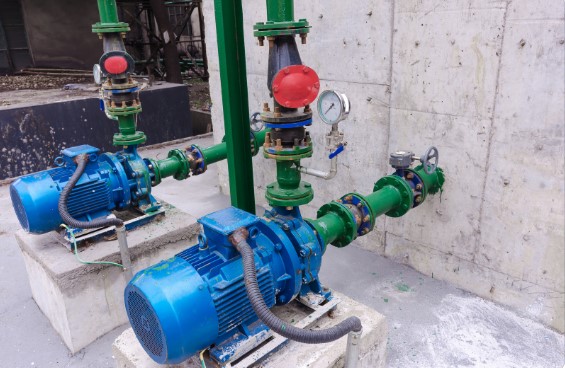 If you rely on a well pump to deliver water to your home or water services for farms, then recognizing the signs of well pump failure is essential. Without proper maintenance and quick repair, an inoperable pump can mean no running water in your house. While it’s easy to overlook problems when everything appears normal up top, paying attention to any changes that could indicate an issue developing beneath the surface can help you nip major issues in the bud before they spiral out of control—and save yourself money and a world of trouble down the road. To arm yourself with useful knowledge about how and why pumps fail, read on for our comprehensive guide on what kind of signs warn about impending pump troubles and ways to get back up and running as soon as possible if something does go wrong!
If you rely on a well pump to deliver water to your home or water services for farms, then recognizing the signs of well pump failure is essential. Without proper maintenance and quick repair, an inoperable pump can mean no running water in your house. While it’s easy to overlook problems when everything appears normal up top, paying attention to any changes that could indicate an issue developing beneath the surface can help you nip major issues in the bud before they spiral out of control—and save yourself money and a world of trouble down the road. To arm yourself with useful knowledge about how and why pumps fail, read on for our comprehensive guide on what kind of signs warn about impending pump troubles and ways to get back up and running as soon as possible if something does go wrong!
Loss of water pressure
Experiencing a loss of water pressure can be quite disconcerting, especially when it occurs unexpectedly or gradually over time. One of the potential culprits behind this issue could be a problem with your well pump.
A well pump is responsible for supplying water to your home, and any malfunctions can lead to inconsistencies in water pressure. When you encounter such an issue, it is essential to act swiftly and seek professional help to diagnose and resolve the matter.
Addressing the problem at an early stage can prevent further damage and costly repairs in the long run, and help maintain the overall quality of your water supply. Remember; a well-maintained well pump is crucial for ensuring consistent water pressure and an uninterrupted flow of fresh water to your home.
Loud noises coming from the pump
The cacophony of loud noises emanating from a pump can be quite unsettling and may signal an issue that requires prompt attention.
There are a couple of potential culprits behind this auditory annoyance: the motor may be wearing out, or something could be obstructing its proper functioning. A worn-out motor not only diminishes the pump’s efficiency, but also risks causing further damage if left unaddressed.
On the other hand, an obstruction in the system can trigger a myriad of issues, ranging from reduced water flow to a complete pump failure. Taking swift action to assess and resolve the underlying problem is key to restoring tranquility and ensuring the longevity of your pump.

Leaks around the pump
Discovering moisture or liquid around your well pump can be quite concerning, as it may be an indication that a replacement is needed in the near future.
This issue should not be taken lightly, as leaks can potentially lead to significant damage and costly repairs if left unaddressed. It is essential to carefully monitor the area for any signs of deterioration or worsening of the problem.
Consulting with a professional and scheduling an inspection can help ensure that your well pump remains in optimal condition and prevent any unwarranted disruptions to your water supply.
In the end, taking the necessary precautions will ultimately contribute to the longevity of your well pump, allowing you to enjoy a reliable and efficient water system in your home.
Unusual electricity usage
Have you recently noticed a sudden increase in your electricity bills without any significant changes to your daily routine? Believe it or not, the culprit of such unusual electricity usage might lie deep underground – it could be a failing well pump.
Well pumps are responsible for drawing groundwater into your home, but with time, they may develop faults or suffer wear and tear. A malfunctioning well pump has to work harder and consume more electricity to deliver the same amount of water, resulting in a spike in your bills.
To prevent further damage and avoid the burden of escalating energy costs, it’s crucial to keep an eye on your electricity usage patterns and address any unexpected changes promptly.
Don’t hesitate to call in a professional to inspect and ensure the optimal functioning of your well pump, potentially saving you from a pricey headache down the road.
Poor water quality
The issue of poor water quality is a significant concern for many, especially if there are signs of contamination in your water supply.
This could be an indicator that your well pump is malfunctioning, putting the health and well-being of you and your family at risk. Not only does this have the potential to affect your everyday activities like cooking, bathing, and cleaning, but it can also lead to long-term health issues due to the consumption of contaminated water.
It’s essential to address this problem promptly by seeking the help of a professional to assess and get them for your well pump repair, ensuring a safe and healthy water supply for your home. By taking these preventative measures, you are contributing to the welfare of both your household and the environment.
Dry wells
when you notice that water is not coming out of your tap as readily as before, it could be due to the failure of the well pump. A failing well pump is often the culprit behind reduced water pressure in your home.
When you notice that your faucet is no longer running as strongly as before, it could be a sign that the well pump has stopped working properly. If you suspect your home may be relying on a dry well, have a professional confirm if the problem lies with the well and if it needs repairs or to be replaced.
In either case, the cause of the problem and how to fix it should become known so you can return to enjoying plentiful supplies of household water.
Conclusion
Well pumps are an essential part of your home’s plumbing system, providing a reliable source of clean and safe water. To ensure that your well pump remains in optimal condition, it is important to keep an eye out for signs of trouble such as sudden rises in electricity bills, poor water quality, or dry wells. If any such issues arise, address the problem promptly by having a professional inspect and repair your well pump. Taking these necessary steps will help to guarantee an uninterrupted water supply for your home, while also contributing to a healthier environment.
